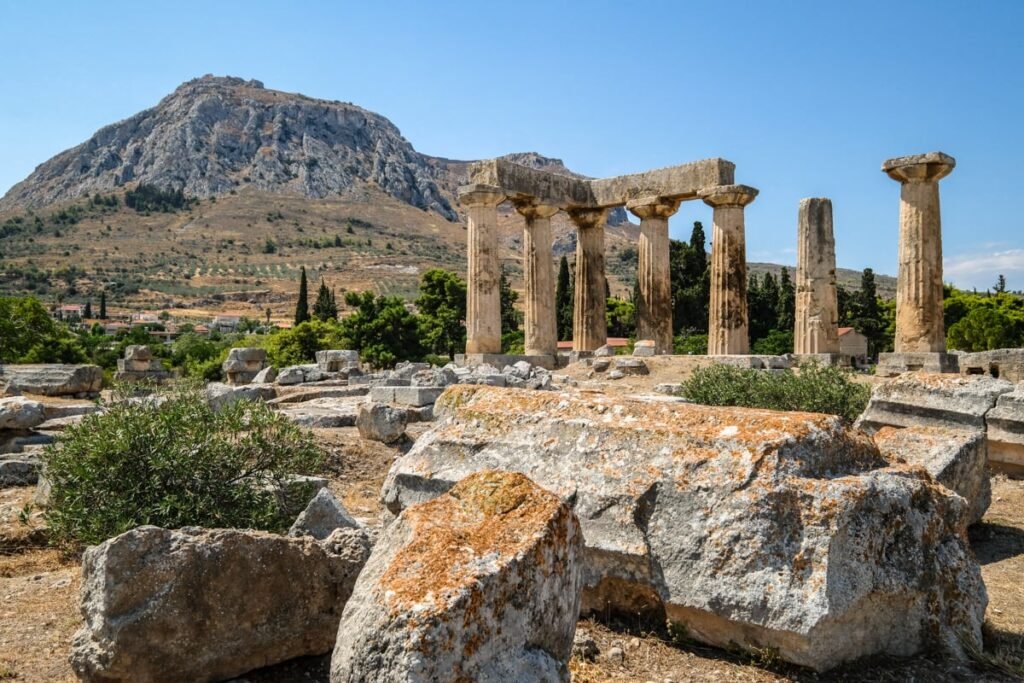Where Is Ancient Corinth?
Ancient Corinth sits at the gateway to the Peloponnese peninsula, roughly 80 kilometers (50 miles) west of Athens.
It’s important to note that the archaeological site of Ancient Corinth is not located in the center of modern Corinth town. Instead, the ruins lie about 8 kilometers (5 miles) further southwest, in a more rural setting surrounded by scenic hills and farmland.
One of the highlights of the site is the Temple of Apollo, a striking remnant from the 6th century BC that still stands proudly against the backdrop of the Corinthian landscape.
How To Get To Ancient Corinth
1. By Guided Tour
The most convenient and stress-free way to reach Ancient Corinth is by joining an organized tour from Athens.
Popular options include half-day guided bus tours directly to the archaeological site, or full-day excursions that combine Corinth with other nearby gems—such as the beautiful seaside city of Nafplio.
We recommend booking through GetYourGuide, as they offer reliable transport, knowledgeable local guides, and smooth itineraries. We’ve personally used them for trips all over the world and always had a great experience.
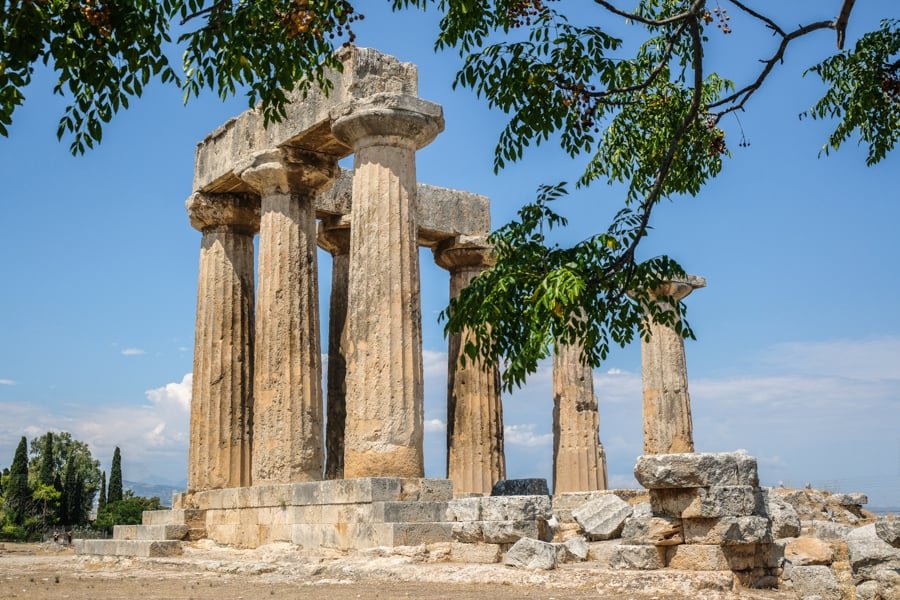
2. By Car
If you prefer flexibility and the freedom to explore at your own pace, renting a car in Athens is an excellent option for visiting Ancient Corinth.
The drive from Athens takes roughly one hour along a well-maintained highway, and you can head directly to either modern Corinth town or the ancient ruins. Having your own vehicle also allows you to make spontaneous stops along the way—such as the Corinth Canal, coastal viewpoints, or charming villages nearby.
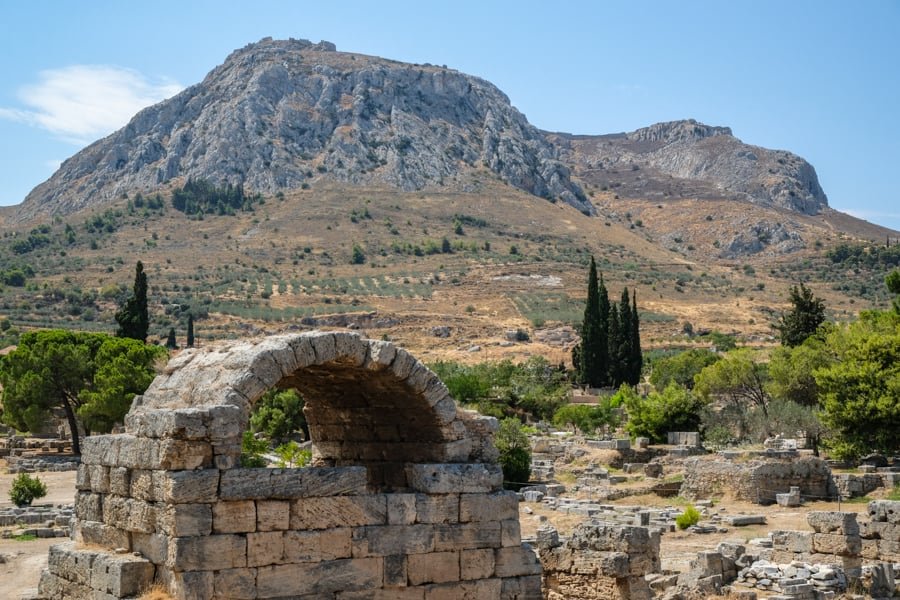
3. By Train
Traveling to Corinth by train from Athens is straightforward and comfortable. Trains depart every two hours from Athens Larissa Station, and the journey takes about 1 hour. Tickets can be purchased directly at the station or online in advance.
Once you arrive Corinth Railway Station, you’ll need to take taxi to reach the Ancient Corinth archaeological site. The drive is short—around 10 minutes—and taxis are readily available both at the station and at the ruins for your return trip.
4. By Bus
The KTEL bus service offers hourly departures from Athens Kifisou Bus Station to the Isthmus of Corinth. The ride also takes roughly 1 hour. Getting off at Isthmus Station is recommended, as it’s closer to the famous Corinth Canal—only about a 2-minute walk away.
From Isthmus, you can hire a taxi for the 15-minute ride to Ancient Corinth. While the bus does go to modern Corinth town, it’s not any nearer to the ruins, so Isthmus remains the more convenient option for most travelers.
You can check the latest schedules and buy tickets on the official KTEL website.
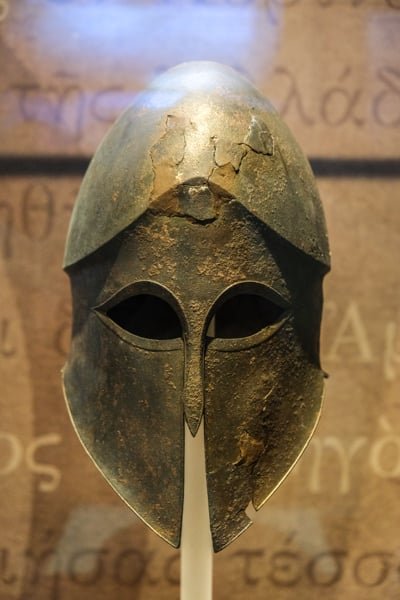
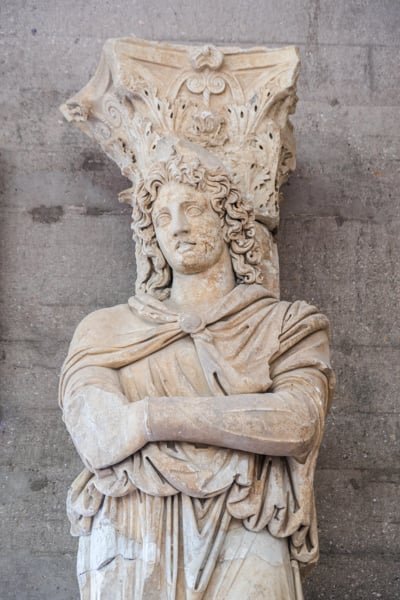
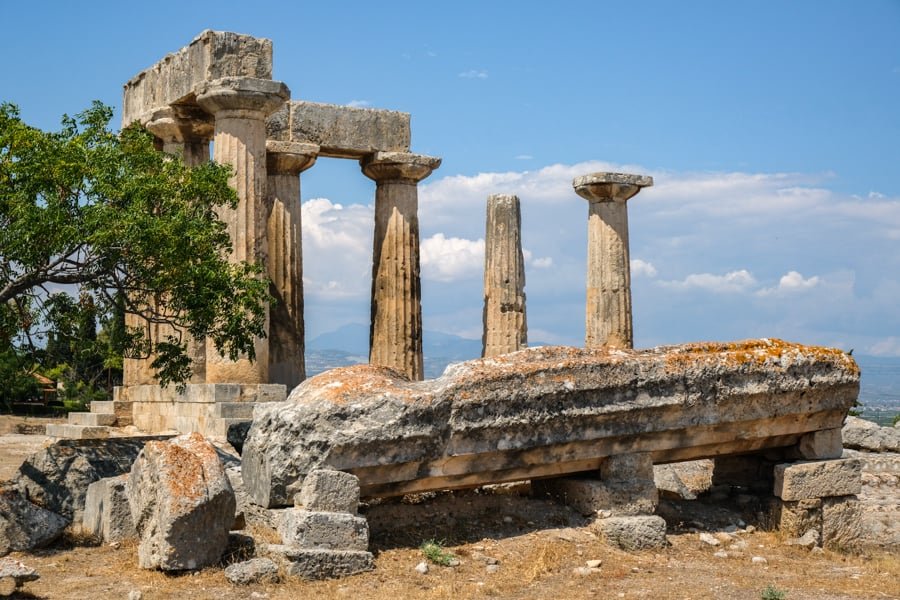
Temple of Apollo
One of the most striking landmarks in Ancient Corinth is the Temple of Apollo, built around 560 BC. Today, only a few of its majestic Doric columns remain standing, yet the site still carries an undeniable grandeur.
Set against the dramatic backdrop of Acrocorinth Mountain, the temple offers a picture-perfect view that feels reminiscent of the Acropolis in Athens—but without the overwhelming crowds.
When we visited the Acropolis, it was so busy that walking through the site was a challenge, and much of the Parthenon was hidden under scaffolding. Ancient Corinth, on the other hand, offers a far more peaceful experience, allowing you to truly take in the beauty and history of the ruins without distraction.
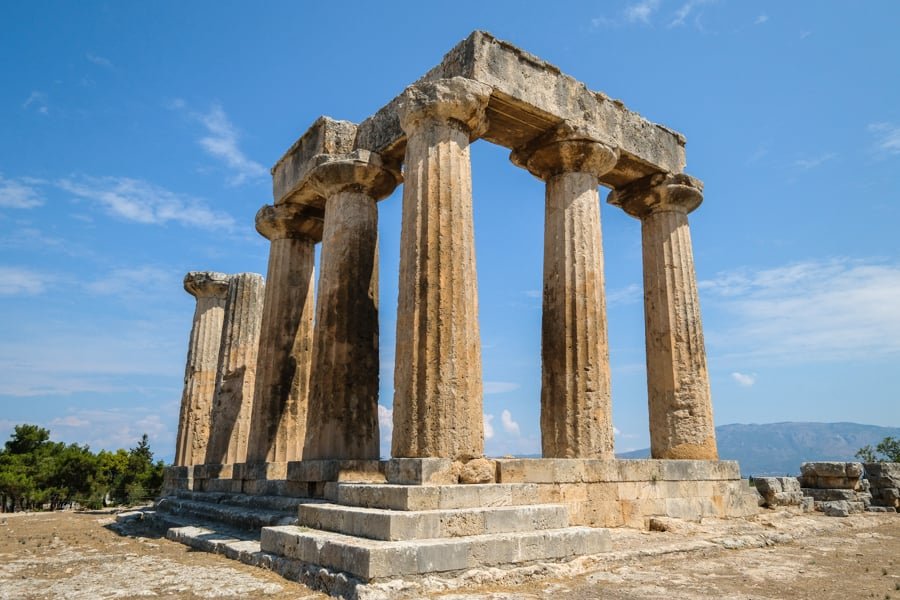
Fountain of Peirene
Dating back to around 500 BC, the Fountain of Peirene was once the primary source of fresh water for the ancient city of Corinth. Although its marble chambers are no longer flowing with spring water, the ruins still offer a glimpse into its past elegance and importance. Standing here, it’s easy to imagine the fountain in its prime—an essential gathering spot for locals and travelers alike.
The Judgement Seat (Bema)
For visitors interested in Biblical history, the Judgement Seat of Corinth is a must-see. According to the Book of Acts (18:12–16), the Apostle Paul was brought before Gallio, the Roman Proconsul of Achaia, accused of teaching against Jewish law. Gallio dismissed the case, saying it was outside his jurisdiction. Today, you can stand at the very spot where this event took place, marked by a sign explaining its historical and religious significance.
Archaeological Museum of Ancient Corinth
Located within the archaeological site, the Archaeological Museum of Ancient Corinth is small but rich in history. The museum houses impressive statues, mosaics, pottery, and artifacts that bring the ancient city to life. Informative signs in English make it easy to understand the exhibits, even if you’re visiting without a tour guide. It’s the perfect final stop after exploring the ruins, offering deeper insight into Corinth’s remarkable past.


How Long to Spend at Ancient Corinth
Visiting the ruins and the Archaeological Museum of Ancient Corinth typically takes just a couple of hours. Including travel time to and from Athens, you’ll want to set aside at least half a day for the trip.
If your schedule allows, consider making it a full-day excursion. This way, you can explore other nearby attractions such as Acrocorinth, with its spectacular hilltop fortress, and the famous Corinth Canal, an engineering marvel connecting the Aegean and Ionian Seas. These extra stops add variety to your itinerary and give you a richer glimpse of the Corinth area’s history and beauty.

Other Things to Do in Corinth, Greece
If you have extra time after exploring the ruins of Ancient Corinth, there are several great attractions and experiences nearby:
- Acrocorinth Fortress – A massive hilltop fortress overlooking Ancient Corinth, offering sweeping views of the sea on both sides of the Isthmus. It’s just a 5-minute drive from the archaeological site, but plan to spend 1–2 hours exploring. The terrain is steep and uneven, so bring a hat, comfortable shoes, and water.
- Paralia Kalamia Beach – The main beach in modern Corinth, known for its clean pebbled shore and plenty of sunbeds, umbrellas, and cafes. Located about 3 km from the train station, it’s a pleasant 30-minute walk.
- Corinth Canal – An engineering marvel built in the 19th century to connect the Aegean and Ionian Seas. You’ll likely pass it on your way from Athens, but it’s worth stopping for a closer look.
- Cenchreae Port – Once the eastern port of Corinth, this peaceful spot holds Biblical significance as the place where the Apostle Paul fulfilled a vow (Acts 18:18). While only ruins remain, the area has a tranquil charm.
- Moni Agias Triadas Monastery – A beautiful monastery located about 8 km south of Corinth, perfect for a quiet cultural visit.
- Paralia Loutra Oreas Elenis – A relaxing beach 15 km southeast of Corinth. This is a great place to enjoy fresh seafood right by the water.

More Greece Travel Guides
Thanks for reading! I hope this guide helps you plan the perfect day trip to Ancient Corinth from Athens.
If you’re exploring more of Greece, check out our other travel guides for inspiration:
- Athens City Guide – Top Things to See & Do
- Visiting Meteora – Monasteries in the Sky
- Santorini Travel Guide – Best Beaches & Sunset Spots
- Delphi Day Trip from Athens – Ancient Ruins & Myths
From historic ruins to breathtaking beaches, Greece is full of incredible destinations waiting to be explored!
